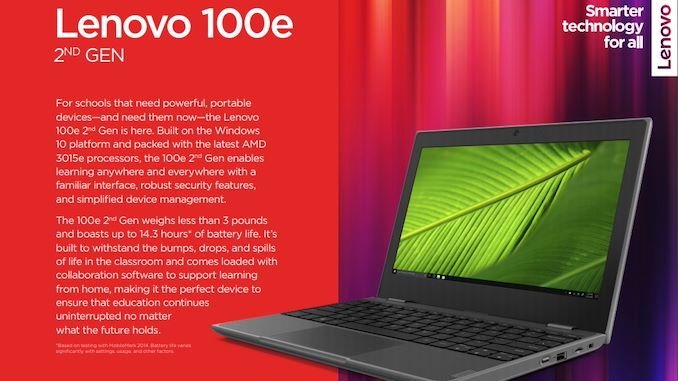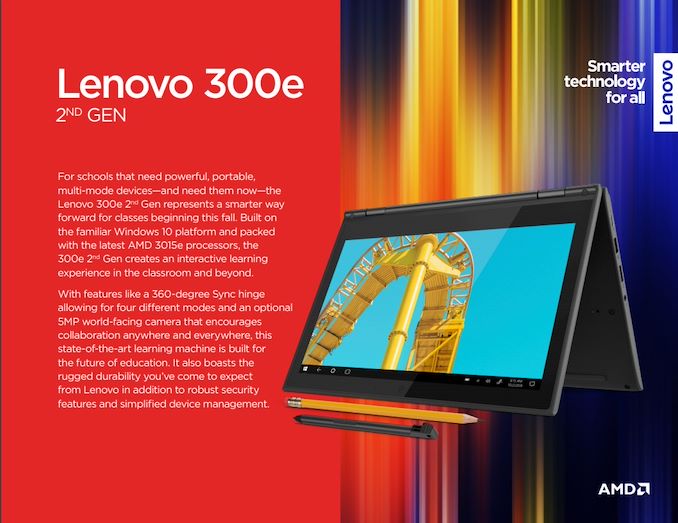AMD Zen now at 6W TDP: Dual Core for Education
by Dr. Ian Cutress on August 4, 2020 10:05 AM EST
At the low-end of AMD’s portfolio, the company uses Athlon Gold and Silver naming for parts that offer fewer cores and lower power consumption. These parts are still based on Zen or Zen+ microarchitecture, paired with a small amount of Vega graphics, indicating that this market is best served with something that is at a low-cost to manufacture but still of sufficient performance for the markets intended. Sitting below those Athlons, two new APUs have popped up in some new Lenovo education-focused designs today.
The two new processors dispense with the Athlon naming, as AMD gets right into it – the AMD 3015e and 3020e use the same lower case ‘e’ ending we last saw on a product line in 2011, indicating the super low power that these processors are rated for. These processors are given a TDP of 6W with two cores and Vega 3 graphics, traditionally what we see in low cost laptops but sufficient for education-style designs.
The silicon these new processors are based on, we believe, is AMD’s Dali silicon. It is the smallest of all AMD’s Zen APU silicon offerings, already in the market as AMD Athlon Mobile. These new parts come in below those specifications.
| AMD Dali-based Zen APUs | |||||||
| AnandTech | Cores Threads |
Base Freq |
Turbo Freq |
GPU | GPU Freq |
DDR4 | TDP |
| Athlon Gold 3150U | 2 / 4 | 2400 | 3300 | Vega 3 | 1000 | 2400 | 15 W |
| Athlon Silver 3050U | 2 / 2 | 2300 | 3200 | Vega 2 | 1100 | 2400 | 15 W |
| Athlon 300U | 2 / 4 | 2400 | 3300 | Vega 3 | 1000 | 2400 | 15 W |
| Athlon Silver 3050e | 2 / 4 | - | 2800 | Vega 3 | 1000 | 2400 | 6 W |
| AMD 3015e | 2 / 4 | 1200 | 2300 | Vega 3 | 600 | 1600 | 6 W |
| AMD 3020e | 2 / 2 | 1200 | 2600 | Vega 3 | 1000 | 2400 | 6 W |
If the set-up looks a bit odd, well, it is. The 3015e has simultaneous multi-threading but a much lower GPU frequency and DDR4 support compared to the 3020e. This might be the trade-off at the 6W power mode.
Lenovo is set to use the new AMD 3015e in two of its new education designs.
The Lenovo 100e 2nd Gen will use this new chip, Windows 10, Wi-Fi 6, 64 GB eMMC, 4 GB DDR4, an 11.6-inch 13x7 display (250 nits), but offer a hard wearing design suitable for bumps and scrapes as well as ~12 hours of battery life, with quick charging providing 80% power in an hour.
The Lenovo 300e 2nd Gen is a similar build but offers a 360-degree hinge, pen support, with an optional 128 GB SSD. Battery is 42 Wh, rated at ~12 hours.
The 100e will start at $219 and the 300e will start at $299, available from September. Both devices have a variety of student-focused software options focusing on teaching and security.











65 Comments
View All Comments
yeeeeman - Tuesday, August 4, 2020 - link
The bezels are from year 2000.rrinker - Tuesday, August 4, 2020 - link
Everyone and their bezels. The tech is what matters, this isn't a fashion show., Plus larger bezels protect the screen far better than these new edgeless designs. And these are intended for schools to hand out to kids. Kids drop things. Better a wide bezel to keep the screen from flexing than some high fashion design that will be broken in the first week.dullard - Tuesday, August 4, 2020 - link
Bezel sizes aren't about fashion--never have been. Complaints about bezel sizes are about this laptop could easily have 50% more screen space for either (A) more productivity of the student or (B) larger fonts for the visually impaired students.I agree with the wide bezels needed for student's carelessness though.
dontlistentome - Tuesday, August 4, 2020 - link
50% more screen = more cost + more power = bigger battery = more cost again.nathanddrews - Tuesday, August 4, 2020 - link
Also, large bezels on a touchscreen 2-in-1 are preferred so you can hold onto the thing. That said, I'd love to see how these stack up to the sub-$300 Intel Pentium/Celeron devices.rahvin - Tuesday, August 4, 2020 - link
The biggest complain with my Pixel2 was the screen rounded around the edges and just holding the thing was touching the screen. It constantly mistakes holding the phone as touching the screen. The pixel2 went way to far in bezel reduction. Touch screen devices meant to be held should have a minimum bezel that's sized large enough to accommodate holding the device, somewhere between the height of the first joint of a finger to an area big enough to accommodate an adults edge of palm.I don't know what the ideal size is but I can tell you all the current devices are way too small. It's good to see real bezels coming back because they are essential to holding the device without touching the screen.
Farfolomew - Wednesday, August 5, 2020 - link
Yep, agree completely. After having used a Dell Win10 tablet for 3 years with relatively huge bezels, moving to a new 2-in-1 with hardly any bezels, I found myself annoyed at unable to hold the damn thing without clicking on some dumb hyperlink on the webpage I was viewing. I thought the small-bezel fad coincided with universally-adopted better palm rejection techniques, but I was way wrong. So either figure out how to fix it with smart software, or make those darn bezels bigger!dullard - Wednesday, August 5, 2020 - link
You do realize that the 100e with the larger bezels is not a touchscreen, right?nathanddrews - Wednesday, August 5, 2020 - link
They look to be the same size.Samus - Tuesday, August 4, 2020 - link
Education-focused laptops have always had large bezels. It aids in impact resistance.